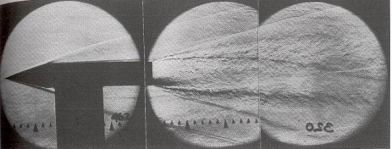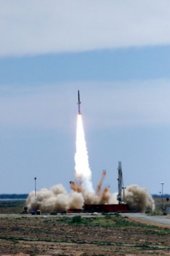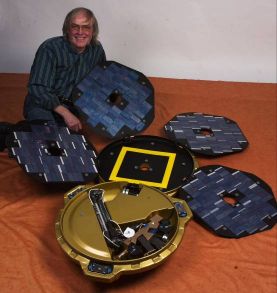| Issue 2 |
During the 1960's under the direction of the Head of Department, the late Professor Douglas Holder, assisted by Donald Schultz, there was much activity on research in hypersonic and supersonic flows. This took place in what is now the Thom Building. At one time there were five wind tunnels capable of providing hypersonic flows operating in the building. These were mainly short duration facilities such as gun tunnels and shock tubes. In particular my shock tunnel at the time produced flows of Mach numbers up to 30, travelling at 3km per second for several milliseconds. One facility, the Low Density Wind Tunnel, achieved Mach 6 continuously but at very low mass flows corresponding to low density at very high altitudes.
The measurement of heat transfer to missile models was an important aspect of the research and the ability to make these measurements led to a new application; that of heat transfer and aerodynamics in gas turbine blading. At the beginning of the 1970's the turbine activity required additional short duration wind tunnels and in particular the Isentropic Light Piston Tunnel which I devised specifically for turbine testing. Ultimately this research led to the establishment of the Rolls Royce University Technology Centre in Heat Transfer and Aerodynamics.
It was apparent that such research could not be accommodated in the Thom Building and Professor Douglas Holder championed the acquisition of the old city electricity generating station at Osney to house the wind tunnels. The move to Osney took place in 1975 and Professor Donald Schultz headed the group until his death in 1987.
A new gun tunnel was acquired from Rolls Royce at this time. This had previously been used on intake development of the Bristol Bloodhound missile many years ago and was much larger than the existing tunnel. This Gun Tunnel spent a decade examining the plumes of rockets, for these hot gases emitted radiation whereby missiles could be detected. A typical example of a Schlieren photograph of rocket and plume is shown below. The rocket is flying at a Mach number of 7, the nozzle flow exhausts at Mach 4 and the complex plume flow structure can be seen.

The Low Density Wind Tunnel, essentially the sole tunnel of its kind now operational in the UK, was moved from the Thom Building to Osney. An example of research done in it is the work performed for NASA on measurement of drag on the Mars Pathfinder probe. The vehicle model was tested by suspending it magnetically in a Mach 6 low density flow and as shown in Andrew Owen's thesis, the data obtained compared well with that derived from the flight trajectory by NASA as the probe decelerated in the Martian atmosphere.
Over recent years hypersonic research has been focussed on Ramjets and Scramjets. Both engines compress the air prior to combustion using the "ram" effect as the air slows down on meeting the vehicle. No compressor is required as in a conventional jet engine. Although SCRAMJETS (Supersonic Combustion Ramjets) have been studied for many years it is only recently that flight testing of such engines has been attempted. The tunnels at Osney have been playing their part in this effort in testing the intakes to ensure that the intake shock is "swallowed" appropriately.
In tests at Woomera in Australia these scramjets were tested by placing them on the nose of a two stage, Terrier/Orion rocket which flew to an altitude of 300 kilometres, well above the earth's atmosphere. At this altitude it turned round and fell back into the atmosphere achieving the correct conditions at 20 kilometres height and a Mach number of 9, whereupon fuel was injected and testing took place for approximately 10 seconds. Two launches have been made so far, one failed due to rocket malfunction and the second was a success and data is still being evaluated in the UK and Australia. The completed Orion rocket/scramjet assembly was tested for stability at Osney Lab as shown in the photograph below.

Osney research student Alex Matthews took part in preparation for these flight tests in collaboration with colleagues from the University of Queensland. The launch of the first rocket is shown below.

Several similar launches to test American and French Scramjet engines using Russian rockets have taken place over the past few years. The current American activity is the testing of HYPER-X; a scramjet / airframe combination model which is launched from a Pegasus satellite launcher in level flight at 20 kilometres altitude. The first test took place a year ago but ended in a rocket failure. NASA continues this development and have asked Osney Lab to look at the HYPER-X - Pegasus separation in the Low Density Wind Tunnel.
The most recent work in the Low Density Wind Tunnel has been on the Beagle 2 Mars Lander. However, before turning to this, its tests in the Gun Tunnel must be mentioned. Beagle 2 is the UK Mars probe which is to be carried to Mars this year (2003) by the European Space Agency Spacecraft, Mars Express. It is to be launched on the Russian rocket Soyuz / Fregat in the middle of the year, to land around Christmas Day. The model of Beagle 2 can be seen below "flying" in a simulated Martian atmosphere at Mach 6 in the Gun tunnel.

Note the strong bow shock which causes severe heating on the front of the capsule necessitating an ablation heat shield during entry. The heat transfer around the capsule was measured in the Gun Tunnel to confirm computational predictions which are crucial in the design of the vehicle.
Beagle 2 carries a wide range of instrumentation; a primary aim being the search for life. However, an anemometer to measure Martian winds is also carried and this was developed with the Atmospheric Physics Department.

The anemometer was manufactured at the Osney Lab and tested in the Low Density Wind Tunnel where conditions on the surface of Mars were reproduced. The anemometer operates by measuring the cooling associated with the wind, similar to a terrestrial device, but has to be extremely sensitive in view of the fact that the Martian atmospheric pressure is approximately one percent of that on the earth.
The Mars Lander as it would appear when deployed on the surface is shown here and the Osney probe is clearly seen as the white disc.

A new initiative by QinetiQ (formerly Defence Evaluation and Research Agency) is the SHYFE programme. SHYFE (Sustained Hypersonic Flight Experiment) is in fact a ramjet operating at exceedingly high temperatures. Osney Lab is to analyse the heat transfer aspects of the vehicle and perform gun tunnel testing. Thus hypersonics, which was instrumental in the development of the University Technology Centre in Heat Transfer and Aerodynamics, still maintains a high profile at the Osney Lab.

|
| The Osney Lab, formerly the Oxford Power Station |
| << Previous article | Contents | Next article >> |
| SOUE News Home |
Copyright © 2003 Society of Oxford University Engineers |
SOUE Home |